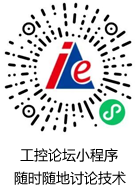问答系列(三十四) 点击:1012 | 回复:0
发表于:2002-11-04 09:19:00
楼主
Two instances of the Assembly Object (#20 and #70) are required to implement the AC Drive device profile. I want to add some other I/O data assignments to control the device. Am I permitted to add additional instances of the Assembly Object (for example, #100)? Will this product be compliant with the AC Device Profile?
Answered by Ray Romito, DeviceNet Trainer,
e-mail:
A98) As long as the additional assembly instances are given a number
in the vendor specific range of 100-199 (decimal), the device profile is compliant with the DeviceNet Specifications. Refer to Volume 2, Chapter 2-6 for additional considerations when extending a device profile.
How can we get the information necessary to create
an EDS file for a device that is not furnished with one?
Answered by Dave Van Gompel, System SIG Member,
e-mail:
A167) Unless it is a product which supports the ability to upload it from the device, you go to the manufacturer and DEMAND it. At a minimum, if the manufacturer does not supply an EDS he should include in his documentation the description of the configurable attributes and their CIA (class, instance, attribute). A user should NEVER, EVER have to generate the EDS himself.
It^s not that we manufacturer^s are trying to keep things secret. It just that by providing an EDS for his product he makes life much more enjoyable for his customer. It^s like releasing a new printer to the market and then not including the printer driver for the user to load into Windows so the buyer can actually use it.
We have a simple device that we could configure using the Basic Configuration mode of Allen-Bradley^s DeviceNetManager software. We are migrating to RSNetworks, which does not appear to have a Basic Configuration mode. I have created an EDS Stub file, but I need to know the proper format to include the parameters that I used to configure with Basic Configuration. Specifically, I need to be able to read/write Attribute 1, Instance 1, Class 100 (decimal) and Attribute 2, Instance 1, Class 100 (decimal).
Answered by Dave Van Gompel, System SIG Member,
e-mail:
A168) The Basic Mode Editor from the "old" DeviceNet Manager Software was included with the first release of RSNetworx/DNet (version 2.0). We apparently fooled people by putting it in a different location AND renaming it. You get to it by doing a right mouse click on the device (after doing a network browse). From the resulting context menu you select the SCIA editor. The acronym SCIA stands for: Service, Class, Instance, Attribute.
The other function you mentioned, the ability to upload the EDS from the devices that support that function (like most all of the Allen-Bradley products do) was not in the 2.0 release. However the current release of RSNetworx for DeviceNet (version2.1) does have the feature/function included.
热门招聘
相关主题
- DEVICENET 现场总线 中文协议...
 [2171]
[2171] - 请教TP170A的组态问题,急~!...
 [1356]
[1356] - 请问Lontalk协议
 [1770]
[1770] - M-BUS和MODBUS的关系
 [1704]
[1704] - 综述:现场总线产品
 [1757]
[1757] - 三菱PLC 和条码通讯程序范例
 [1942]
[1942] - PROFIBUS:简介
 [6930]
[6930] - 综述:流行现场总线简介
 [6025]
[6025] - 中国软件业发展架构
 [1576]
[1576] - 虚拟专用网VPN系列讲座(六)...
 [1898]
[1898]

官方公众号

智造工程师
-

 客服
客服

-

 小程序
小程序

-

 公众号
公众号

















 工控网智造工程师好文精选
工控网智造工程师好文精选
